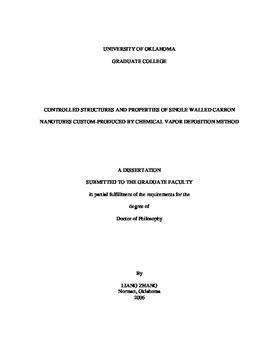| dc.contributor.advisor | Resasco, Daniel E., | en_US |
| dc.contributor.author | Zhang, Liang. | en_US |
| dc.date.accessioned | 2013-08-16T12:20:25Z | |
| dc.date.available | 2013-08-16T12:20:25Z | |
| dc.date.issued | 2006 | en_US |
| dc.identifier.uri | https://hdl.handle.net/11244/1112 | |
| dc.description.abstract | Single walled carbon nanotubes (SWNT) are considered as one of the most promising nanomaterials for a large variety of applications that require SWNTs with controlled structures and properties, which is the main focus of this dissertation. The first approach to tackle this problem is to develop appropriate methods to synthesize SWNTs of controlled structure. To achieve this goal, a number of techniques have been developed to selectively grow SWNTs on different support from porous silica to flat substrates. It is demonstrated that a precise control over chirality, diameter and bundle size can be obtained by tuning the reaction temperature in the growth of SWNT over Co-Mo/silica powder by CO disproportionation. In addition, a novel method for selective growth of SWNT on flat substrates has been developed. In this method, SWNTs can be grown either in random direction or vertical alignment on the surface under standard CoMoCATRTM reaction conditions. The second trust of this dissertation is to investigate the properties of as-produced SWNTS with their controlled structural parameters (i.e., diameter, bundle size, chirality, and alignment). Field emission measurements have been conducted to evaluate the dependence of the emission characteristics on the SWNT structure. For the nanotubes grown on flat substrates, the response of the vertically aligned SWNT to polarization of both X-rays (in XANES) and visible light (in Raman) clearly revealed the anisotropic optical properties of V-SWNT. Finally, efforts have been made to explore the growth mechanism of VSWNT on flat substrate. X-ray photoelectron spectroscopy and atomic force microscopy conducted on the flat surface with deposited catalyst gave detailed information about the chemical status of Co-Mo catalyst and their morphological distribution. The evolution of the growth of VSWNT with time was visualized by scanning electron the chemical status of Co-Mo catalyst and their morphological distribution. The evolution of the growth of VSWNT with time was visualized by scanning electron microscopy and clearly demonstrated a two-step process involving the formation of a crust layer followed by a concerted growth constrained by crust. Then a kinetic study with fitted growth data has been derived and the maximum growth rate estimated (i.e. 12.5 nm/sec). In addition to the growth of VSWNT, oxidation and transferring of VSWNT has been investigated for future applications. | en_US |
| dc.format.extent | xix, 188 leaves : | en_US |
| dc.subject | Fullerenes. | en_US |
| dc.subject | Engineering, Chemical. | en_US |
| dc.subject | Nanotubes. | en_US |
| dc.subject | Chemical vapor deposition. | en_US |
| dc.title | Controlled structures and properties of single-walled carbon nanotubes custom-produced by chemical vapor deposition method. | en_US |
| dc.type | Thesis | en_US |
| dc.thesis.degree | Ph.D. | en_US |
| dc.thesis.degreeDiscipline | School of Chemical, Biological and Materials Engineering | en_US |
| dc.note | Source: Dissertation Abstracts International, Volume: 67-10, Section: B, page: 5908. | en_US |
| dc.note | Adviser: Daniel E. Resasco. | en_US |
| ou.identifier | (UMI)AAI3238431 | en_US |
| ou.group | College of Engineering::School of Chemical, Biological and Materials Engineering | |
